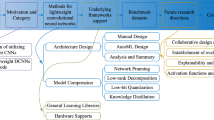Abstract
Edge devices such as smartphones or embedded computing platforms require a resource-aware approach. Therefore, it is often necessary to modify CNN models to make them compatible with the limited infrastructure. The diversity of solutions raises the question of how specific techniques may affect model performance. We address this question by empirically evaluating many techniques proposed in the literature on ResNet-101 and VGG-19 architectures. Our main contribution is the ablation study of how different approaches affect the final results in terms of the reduced number of model parameters, FLOPS, and unwanted accuracy drops. Thus, we also presented the possibility of implementing architecture compression methods that interfere with the low- or high-level model structure. We achieved a reduced ResNet-101 model with about 280 times fewer parameters with only 3.51 pp. accuracy drop compared to the baseline. We also performed post-training methods: pruning and quantization at different model sparsity levels. (All results are fully reproducible, the source code is available at https://github.com/artur-sobolewski/CNN-compression)
Access this chapter
Tax calculation will be finalised at checkout
Purchases are for personal use only
Similar content being viewed by others
References
Khan, A., et al.: A survey of the recent architectures of deep convolutional neural networks. Artif. Intell. Rev. 53 (2020). 10 Artur Sobolewski and Kamil Szyc
Zhang, X., et al.: Shufflenet: an extremely efficient convolutional neural network for mobile devices. In: Proceedings of the IEEE Conference on Computer Vision and Pattern Recognition (2018)
Howard, A., et al.: Searching for mobilenetv3. In: Proceedings of the IEEE/CVF International Conference on Computer Vision (2019)
Simonyan, K., Zisserman, A.: Very deep convolutional networks for large-scale image recognition (2014). arXiv:1409.1556
He, K., et al.: Deep residual learning for image recognition. In: Proceedings of the IEEE Conference on Computer Vision and Pattern Recognition (2016)
Szegedy, C., et al.: Rethinking the inception architecture for computer vision. In: Proceedings of the IEEE Conference on Computer Vision and Pattern Recognition (2016)
Chollet, F.: Xception: deep learning with depthwise separable convolutions. In: Proceedings of the IEEE Conference on Computer Vision and Pattern Recognition (2017)
Hu, J., Shen, L., Sun, G.: Squeeze-and-excitation networks. In: Proceedings of the IEEE Conference on Computer Vision and Pattern Recognition (2018)
Liang, T., et al.: Pruning and quantization for deep neural network acceleration: a survey. Neurocomputing 461 (2021)
P Véstias, M.: A survey of convolutional neural networks on edge with reconfigurable computing. Algorithms 12(8) (2019)
Qassim, H., Verma, A., Feinzimer, D.: Compressed residual-VGG16 CNN model for big data places image recognition. In: 2018 IEEE 8th Annual Computing and Communication Workshop and Conference (CCWC). IEEE (2018)
Alzubaidi, L., et al.: Review of deep learning: concepts, CNN architectures, challenges, applications, future directions. J. Big Data 8 (2021)
Iandola, F.N., et al.: SqueezeNet: AlexNet-level accuracy with 50x fewer parameters and! 0.5 MB model size (2016). arXiv:1602.07360
Lin, M., Chen, Q., Yan, S.: Network in network (2013). arXiv:1312.4400
Sandler, M., et al.: Mobilenetv2: inverted residuals and linear bottlenecks. In: Proceedings of the IEEE Conference on Computer Vision and Pattern Recognition (2018)
Han, K., et al.: Ghostnet: more features from cheap operations. In: Proceedings of the IEEE/CVF Conference on Computer Vision and Pattern Recognition (2020)
Author information
Authors and Affiliations
Corresponding author
Editor information
Editors and Affiliations
Rights and permissions
Copyright information
© 2023 The Author(s), under exclusive license to Springer Nature Switzerland AG
About this paper
Cite this paper
Sobolewski, A., Szyc, K. (2023). A Study of Architecture Optimization Techniques for Convolutional Neural Networks. In: Zamojski, W., Mazurkiewicz, J., Sugier, J., Walkowiak, T., Kacprzyk, J. (eds) Dependable Computer Systems and Networks. DepCoS-RELCOMEX 2023. Lecture Notes in Networks and Systems, vol 737. Springer, Cham. https://doi.org/10.1007/978-3-031-37720-4_25
Download citation
DOI: https://doi.org/10.1007/978-3-031-37720-4_25
Published:
Publisher Name: Springer, Cham
Print ISBN: 978-3-031-37719-8
Online ISBN: 978-3-031-37720-4
eBook Packages: Intelligent Technologies and RoboticsIntelligent Technologies and Robotics (R0)




